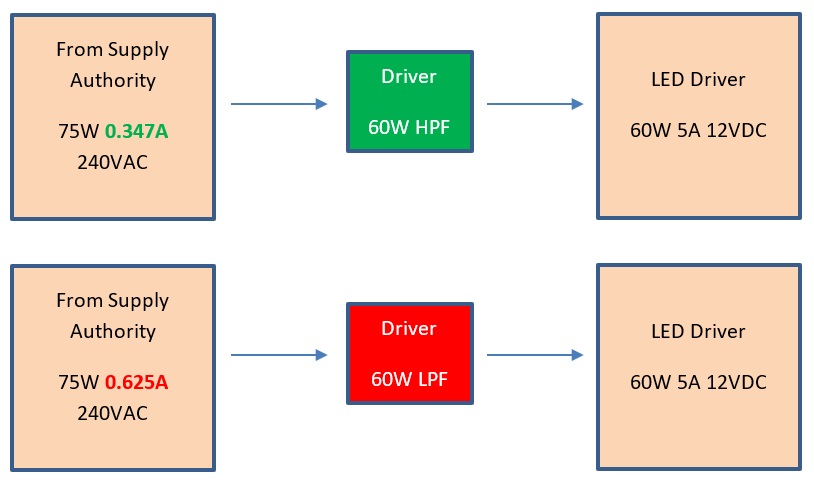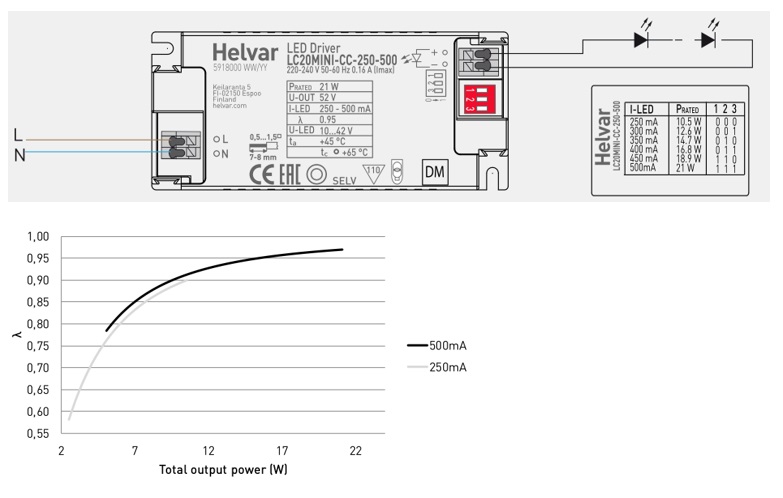These appeal to lighting sellers because they don’t have to keep as many different products on the shelf – one product can fit multiple needs.
However these products tend to have poor power factor when switched into low power mode.
Poor power factor will have negative impacts on your site, and for businesses who are billed KVA demand charges (generally any business spending more than $2,000 per month on power) this will also mean higher power costs.
1. Power Factor Explained
The simplest analogy to explain Power Factor is a glass of beer. While you pay for a full glass of beer, some of the beer is actually froth. A beer with a high power factor has very little froth, while a beer with a low power factor would have a lot of froth.
Power factor is defined as the power input in watts divided by the product of the driver input voltage and driver input current. The power factor of an LED driver is a number between 0 and 1 - the ratio of the real power consumed by the LED to the apparent power in the circuit.
Power Factor = Real Power (Watts) / Apparent Power (Volt-Amps)
Example – A LED lamp rated at 18 watts(real power), when measured draws 20 volt-amps (apparent power). The power factor for that lamp and driver combination is 18W / 20VA, which equals 0.9.
A power factor closer to 1 means there are less losses in the system.
Poor power factor is a consequence of poor circuit design in the drivers controlling the LEDs. Distortions are created in the waveforms between the voltage and current within the system and it is the level of distortion that determines the degree of energy loss.
High Power Factor Driver >= 0.9pf -/- Low Power Factor Driver <= 0.5pf to 0.9pf
Example – 60W LED Driver

Lower Power Factor is Bad for Our Energy Grid and Environment
Most electricity users pay for watts consumed (kWhr). But Supply Authorities must generate amperage, so LPF drivers with higher amperage are more costly to Supply Authorities and harm the overall power grid. The grid has to produce more power than is actually used.
Lower Power Factor is Means Higher Power Costs
Furthermore, larger energy users (those using more than 100 MWH p.a.) are charged daily or monthly Demand charges, which are often in KVA – something affected by Power Factor.
There is also a transition underway for all users to be billed in KVA.
Lower Power Factor Means More Circuits Are Required On Site
HPF driver draws 0.347A & LPF driver draws 0.625A -/- 20A breaker: Loaded to 16A
HPF Driver: Can load 46 drivers on one circuit -/- LPF Driver: Can load 25 drivers on one circuit.
So, if LPF drivers were used in an installation; more circuits would be required costing the user.
Products using dip-switch to change current / dual / multiple wattage products
Example 1 – Tridonic LC 20W 350/500/700mA flex C SR ADV

This driver uses terminals to change between current. As can be seen from the graph, with full load and 700mA the Power Factor is 0.945; which drops to 0.865 when using 50% of the load and 350mA.

This driver uses dip-switch to change between current. As can be seen from the graph, with full load and 500mA the Power Factor is 0.97, which drops to 0.9 when using 50%of the load and 250mA.
Conclusion
Dual Wattage products tend to have lower Power Factors, which negatively impacts the national grid, and the specific site.
Even though dip-switch / dual / multiple wattage products offer convenience to sellers by reducing the number of products they need to keep on the shelf; they come with downsides. On projects with a large number of lights, even a small change in power factor can make a large difference to the cost, energy loss and compliance of a site. So in an ideal scenario, it’s best to have dedicated drivers with single current / power ratio and a high power factor.
For end users these products have appeal due to being customisable, but in reality most products are set once then forgotten and never changed again.
There are of course benefits to having dual switchable lights such as less redundant stock being kept on the shelf which potentially means less waste and less landfill. But they should be used sparingly.

